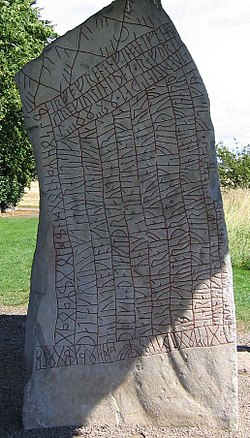Old East Norse
The phoneme ʀ, which evolved during the Proto-Norse period from z, was still clearly separated from r in most positions, even when being geminated, while in OWN it had already merged with r. Monophthongization of æi > ē and øy, au > ø̄ started in mid-10th-century Denmark.
[1] Compare runic OEN: fæigʀ, gæiʀʀ, haugʀ, møydōmʀ, diūʀ; with Post-runic OEN: fēgher, gēr, hø̄gher, mø̄dōmber, diūr; OWN: feigr, geirr, haugr, meydómr, dýr; from PN *faigiaz, *gaizaz, *haugaz, *mawi- + dōmaz (maidendom; virginity), *diuza ((wild) animal).
Feminine o-stems often preserve the plural ending -aʀ while in OWN they more often merge with the feminine i-stems: (runic OEN) *sōlaʀ, *hafnaʀ/*hamnaʀ, *vāgaʀ while OWN sólir, hafnir and vágir (modern Swedish solar, hamnar, vågar; suns, havens, scales; Danish has mainly lost the distinction between the two stems with both endings now being rendered as -er or -e alternatively for the o-stems).
The plural ending of ja-stems were mostly preserved while those of OWN often acquired that of the i-stems: *bæðiaʀ, *bækkiaʀ, *væfiaʀ while OWN beðir (beds), bekkir, vefir (modern Swedish bäddar, bäckar, vävar).
Dræpær maþær vtlænskan man, eigh ma frid flyia or landi sinu oc j æth hans.
Dræpær maþær vtlænskæn prest, bøte sva mykit firi sum hærlænskan man.
Varþær suþærman dræpin ællær ænskær maþær, ta skal bøta firi marchum fiurum þem sakinæ søkir, ok tvar marchar konongi.
If someone slays a Swede or a Smålander, a man from the kingdom, but not a West Geat, he will pay eight örtugar (20-pence coins) and thirteen marks, but no weregild.
